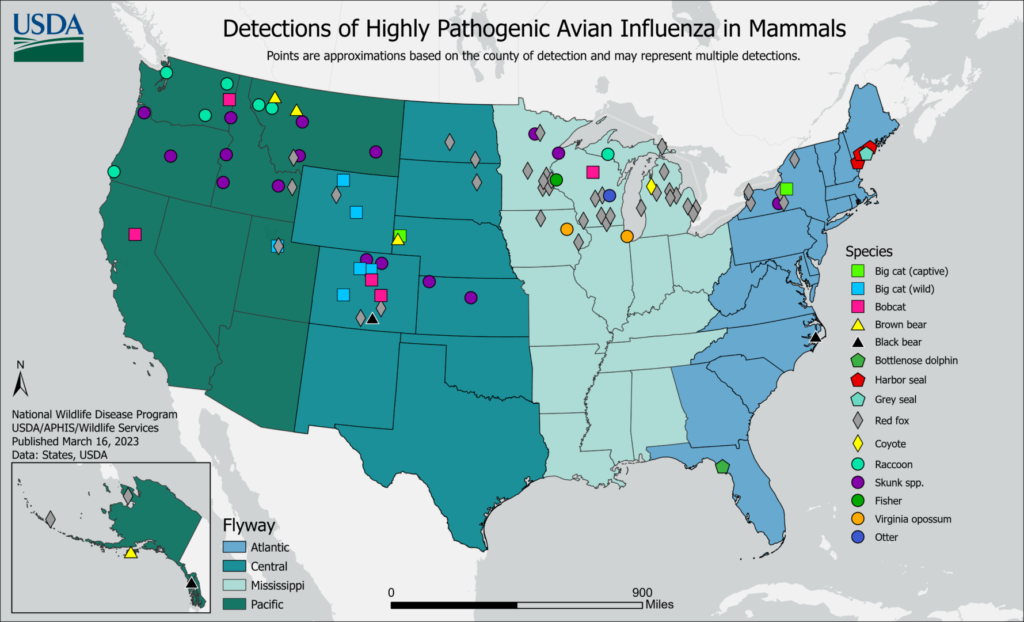The media continues to warn about the threats of an avian bird flu becoming the “next pandemic,” as there are increasing reports of it spreading to more animals in the wild and people as well, which could lead to a mass-extinction of mankind.
In April of 2022 The WinePress cited former CDC Director Dr. Robert Redfield, adamantly said he believes that the next major global pandemic will be that of bird flu, that will have a lethality of anywhere between 10-50% lethality, and vaccines need to be created to counteract it.
He said in the interview:
Yeah I think we have to recognize – I’ve always said that I think the Covid pandemic was a wakeup call. I don’t believe it’s the great pandemic.
I believe the great pandemic is still in the future, and that’s going to be a bird flu pandemic for man. It’s gonna have significant mortality in the 10-50% range. It’s gonna be trouble.
And we should get great prepared for it. I do believe the pandemic risk is a greater risk of the national security of the United States more than [North] Korea, China, Russia, Iran; and we ought to start investing proportional to that national security risk so that we’re prepared.
Unfortunately we’re not more prepared today then when the [Covid-19] pandemic, when I was [the] CDC Director. And we need to make proportional investment so that we are prepared, not the least of which is enhancing our manufacturing capability.
So now that we have new technology like the mRNA technology: it’s great that I can make a vaccine in 2, 4, 6, 8 weeks. But it doesn’t help me if I can’t manufacture 330 million doses.
So, this is a serious issue. I don’t think our politicians are focused on the magnitude of this issue. This needs to be approached with a budgetary perspective measured in multiple aircraft carriers, not in the 5, 8,10 million dollar budget we spend on public health on this nation.
Redfield warned
The potential for a bird flu pandemic touted by Redfield has flown under the radar since, but the World Health Organization and Director-General Tedros Adhanom Ghebreyesus warned in February that H5N1 bird flu has become something for them to monitor, as it reportedly has begun spreading to a variety of mammals out in the wild, but said it did not pose a threat to humans as of yet. Nevertheless he advised the use of vaccines and antivirals to curb this spread if needed.
Over the past few weeks there have been several reports of mammals including minks, otters, foxes and sea lions having been infected with H5N1 avian influenza.
H5N1 has spread widely in wild birds and poultry for 25 years, but the recent spillover to mammals needs to be monitored closely.
For the moment, WHO assesses the risk to humans as low.
Since H5N1 first emerged in 1996 we have only seen rare and non-sustained transmission of H5N1 to and between humans.
But we cannot assume that will remain the case, and we must prepare for any change in the status quo.
[…] WHO is also continuing to engage with manufacturers to make sure that if needed, supplies of vaccines and antivirals would be available for global use. Tedros said
Roughly a week before The WP published a report about the WHO’s warnings about the spread of bird flu, Popular Mechanics published a piece titled “A Malignant Flu May Soon Evolve to Infect and Kill Humans, Report Says.” The outlet cited a recently published study that said Spain had to cull 50,000 mink because H5N1 “likely spread across the animals,” which was enough for Spanish officials to order the termination of the farm’s mink.
The scientists involved in the study say this “may” have confirmed the mammal-to-mammal spread, which therefore means this could mean this strain of bird flu could spread to us in great numbers.
It could have deadly consequences. This is an infection that has epidemic and pandemic potential. I don’t know if people recognize how big a deal this is.
Isaac Bogoch, an infectious disease specialists, said commenting on the study
Popular Mechanics wrote: ‘So far, the human infections link to contact with an infected bird, which is why the mammal-to-mammal possibility becomes the troubling part of this entire scenario. If a mammal, such as a mink, can become an intermediary host, the virus can then mutate to pose an even greater risk to other mammals, including humans.’
And so what’s concerning about this, is that this is exactly the kind of scenario you would expect to see that could lead to this type of adaptation, that could allow these viruses to replicate better in other mammals—like us.
Louise Moncla, a University of Pennsylvania school of veterinary medicine assistant professor, said in response to the study
SEE: Canadian Scientists Claim To Have Discovered A New Covid Variant In Deer That Could Spread To Humans
Then less than a week after The WP published its report on the WHO’s warnings concerning avian flu, Daily Mail published a piece on February 14th, warning that the bird flu could infect and kill half of the population. The headline reads: “Bird flu may mutate to kill more than 50% of humans who catch it, as a result of ‘unprecedented’ outbreak sweeping mammals, experts fear.”
Daily Mail cited a press statement courtesy of the World Organization for Animal Health (WOAH), warning that mammals link mink could act as “mixing vessels” for the disease to fester, evolve, and spread.
The current situation highlights the risk that H5N1 avian influenza may become better adapted to mammals, and spill over to humans and other animals. In addition, some mammals, such as mink, may act as mixing vessels for different influenza viruses, leading to the emergence of new strains and subtypes that could be more harmful to animals and/or humans.
Recently reported infections in farmed mink are a concern because infections of large numbers of mammals kept in close proximity of each other exacerbate this risk. Several studies are currently on-going to further explore the virulence and transmissibility (including between mammals) of these viruses.
PREVENT the spread of the disease by implementing strict biosecurity measures in poultry holdings. In particular, step up the biosecurity around mink farms to avoid the introduction of the virus.
WOAH wrote in a statement, also advising the wearing of PPE when investigating or dealing with infected animals
Daily Mail added that, ‘According to the European Centre for Disease Prevention and Control, the bird flu death rate is believed to already be around 50 percent globally.’
That same day Outdoor Life also reported that bird flu is reportedly spreading and killing a wide spectrum of mammals, including some that are exclusive aquatic. The magazine cited a press release from Colorado Parks and Wildlife on February 9th, stating that a skunk, one mountain lion, and one black bear have succumb to an avian flu infection.
According to the U.S. Department of Agriculture’s Animal and Plant Health Inspection Service (APHIS), the government has been documenting the number of bird flu cases and deaths in other animals. The list was recently updated as of March 17th. This list includes animal deaths across the U.S. from coast to coast, ranging from skunk, to seals, to bears, to fox, to mountain lions, to raccoons, to even a bottlenose dolphin in Florida.

In the case of the bottlenose dolphin – an animal that lives 100% of its life in the water – scientists at the University of Florida believed that this dolphin must have been around a dead bird that had the viral strain.
Although avian flu infection had never been documented in a dolphin, the high incidence of the virus in wild birds within the state in the spring — specifically aquatic bird species such as ducks, gulls, terns and herons — suggested that encounters between dolphins and dying or dead birds near the shoreline was not out of the realm of possibility.
Andrew Allison, Ph.D., an assistant professor of veterinary virology at UF, said
While obviously the presence of HPAIV is a concern, the key takeaway for us is that additional caution should be taken by those handling or encountering wild dolphins during rescue events or while performing necropsies.
Mike Walsh, D.V.M., a clinical associate professor with UF’s College of Veterinary Medicine, who leads the animal rescue team and performed the dolphin’s necropsy with others, said
But because of this virus’ suppositive spread, the media has still continued to speculate that this could very easily trigger the “next pandemic,” and vaccines may be the way to finally stop this spread.
On March 16th the German-based outlet DW floated out an article titled, “Bird flu outbreak: Will it cause the next pandemic?”
Humans are mammals as well. So, if the virus is showing some suggestion of mammalian adaptation — its ability to spread in a mammalian host — that’s just one step closer to it having biological characteristics which [would] make it more attractive to spread in the human population.
Richard Pebody, head of the High-threat Pathogen Team at WHO/Europe, said in a statement
Two days prior to that report, the Irish Independent published a headline that read, “Fears bird flu could trigger next pandemic but watchdog says risks to general population low for now.” Even though the scientists believe that the risk to humans is still low, the researchers quoted believe that more deaths of poultry will rise this year.
However, governments are working to bring out a vaccine to curb the spread. The Independent wrote:
It emerged yesterday that officials in the UK and US are considering plans to roll out a bird flu vaccine in poultry. France is on track to start vaccinating farmed birds in September and Ecuador has unveiled plans for two million inoculations.
The view is that culling is no longer enough and vaccination may be needed to prevent spread.
The Irish paper wrote
The United States and the Biden administration have also began testing a new bird flu vaccine, announced last month. On March 10th a National Security Council official reaffirmed these exploits to CNN.
As a part of the administration’s focus on addressing any infectious disease with urgency and preparedness, we continue to monitor the avian flu outbreak. There are a range of options the United States regularly considers when there is any outbreak that could affect the security and safety of the United States’ food supply.
Right now, we are focused on promoting and enhancing high-impact biosafety practices and procedures.
The official said
Moreover the CDC also told CNN,
This is why it’s so important that both the public health and animal health side take precautions to limit exposures among animal species and between animals and people, and thus limit the chances that some type of virus reassortment event that may allow these viruses to infect people easily and spread easily between people.
An official said in an email to CNN
But other other scientists are working on vaccines for humans as well to prevent the spread of bird flu. CNN reported the following:
Scott Hensley, a professor of microbiology at the University of Pennsylvania, and colleagues have been working on a vaccine candidate that could be used in humans if the virus started circulating among people.
We think that the vaccine will elicit very high levels of neutralizing antibodies against this specific strain because it’s basically perfectly matched to what’s circulating now.
Hensley said.
The vaccine seems to work well in the lab, he said, and the researchers plan to test it on chickens this spring.
The CDC says it recently produced a candidate vaccine virus, an influenza virus that manufacturers can use to make a vaccine, that is nearly identical to a viral protein detected in birds and mammals. It could be used to produce a vaccine for people “if needed.”
Such a vaccine would be expected to provide good protections against circulating H5N1 viruses.
The CDC said. The agency said it has shared this with vaccine manufacturers.
For years, the Southeast Poultry Research Laboratory, a division of the US Department of Agriculture, has also been working on a vaccine for potential emergency use in animals. There may be an advantage to vaccinating poultry to reduce the chances that the virus could mutate.
Vaccinating poultry against avian flu, is “not something that’s really done in our country, but I think it’s time to think about that for sure,” Hensley said.
Farm animals, including birds, are already vaccinated for other diseases. Chickens, for example, routinely get vaccinated for Marek’s disease, which caused by a herpesvirus. They’re also vaccinated against Newcastle disease, a respiratory illness; infectious bronchitis; and acute necrotic proventriculitis, a viral disease that affects the immune system.
Avian flu may someday be included in that list, according to a spokesperson for the USDA.
In the interest of leaving no stone unturned in the fight against (highly pathogenic avian flu), USDA continues to research vaccine options that can protect poultry from this persistent threat.
The spokesperson told CNN.
Vaccination, though, is not the first option.
From vaccine development to production timelines to dissemination to flocks, there are many factors that make implementing a vaccine strategy a challenge, and it would take time to deliver an effective vaccine.
[So first and foremost], we are pursuing collaborative efforts with poultry farmers and companies on education, training, and implementation of comprehensive biosecurity measures. Biosecurity is the best and most prudent approach we have to mitigate the impact of the disease today. The USDA said.
Lastly, on March 2nd, Scientific American floated out a headline titled, “Vaccine Makers Are Preparing for Bird Flu.” In that post Michael Osterholm, director of the University of Minnesota’s Center for Infectious Disease Research and Policy, said:
None of us know when the next influenza pandemic will emerge. It could be tomorrow [or] it could be years from now, and we don’t know which of the viruses will become the next pandemic virus.
At the outset, you have to say there is uncertainty, with one exception: there will be a pandemic.
AUTHOR COMMENTARY
Not even Flipper is safe anymore!

I have long warned that this “next pandemic” will be zoonotic; and it appears that bird flu just might be the one ‘they’ are going with this time around. Whatever they call it is irrelevant: the point is that it is zoonotic, so livestock and wildlife can be culled in huge numbers, including through vaccines, while pulling meat off of the shelves at stores, and consolidating the national food supplies some more. We know that these globalists want to get the masses to stop eating meat: this is their ticket, whilst giving the population a haircut.
Stay vigilant and be ready.
[1] Now the Spirit speaketh expressly, that in the latter times some shall depart from the faith, giving heed to seducing spirits, and doctrines of devils; [2] Speaking lies in hypocrisy; having their conscience seared with a hot iron; [3] Forbidding to marry, and commanding to abstain from meats, which God hath created to be received with thanksgiving of them which believe and know the truth. 1 Timothy 4:1-3
[7] Who goeth a warfare any time at his own charges? who planteth a vineyard, and eateth not of the fruit thereof? or who feedeth a flock, and eateth not of the milk of the flock? [8] Say I these things as a man? or saith not the law the same also? [9] For it is written in the law of Moses, Thou shalt not muzzle the mouth of the ox that treadeth out the corn. Doth God take care for oxen? [10] Or saith he it altogether for our sakes? For our sakes, no doubt, this is written: that he that ploweth should plow in hope; and that he that thresheth in hope should be partaker of his hope. (1 Corinthians 9:7-10).
The WinePress needs your support! If God has laid it on your heart to want to contribute, please prayerfully consider donating to this ministry. If you cannot gift a monetary donation, then please donate your fervent prayers to keep this ministry going! Thank you and may God bless you.








Explains why they brought that old corrupt insider back as one of the ‘heroes’ having second thoughts. Initiated & hooked in, for sale, & endlessly useful.
The media whores were talking about “bird flu” way back in 1999 to the point where it was a source of irritation to a comedian that has since passed away in good health. That’s 24 years of talking of this new, yet not new, public hearth bogeyman. They’ve been crying wolf too long and I do not believe one word of their pseudoscience spiel. Zoonotic diseases between animals and humans, as far as I can remember, were never much of a concern unless the human was bitten by the animal, as in rabies. Otherwise, I was taught it was almost nonexistent. Recently I’ve learned that rabies might just be another Catholic fairy tale, and I have never known of anyone who contracted rabies. My belief is that it is only vaccinated animals that get rabies, and I have heard they are making a big push to get out these rabies vaccines.